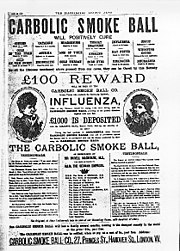Carlill v. Carbolic Smoke Ball Co.
| Carlill v Carbolic Smoke Ball Co | |
|---|---|
 |
|
| Court | Court of Appeal |
| Full case name | Louisa Carlill v Carbolic Smoke Ball Company |
| Decided | 7 December 1892 |
| Citation(s) | [1892] EWCA Civ 1, [1893] 1 QB 256 |
| Case history | |
| Prior action(s) | Carlill v Carbolic Smoke Ball Co [1892] 2 QB 484 (QBD) |
| Subsequent action(s) | none |
| Case opinions | |
| All three Lords Justices of Appeal | |
| Court membership | |
| Judge(s) sitting | Lindley LJ, Bowen LJ and AL Smith LJ |
| Keywords | |
| Advertisements, Conditions, Insurance, Offer and acceptance, Wagering contracts | |
Carlill v Carbolic Smoke Ball Company [1892] EWCA Civ 1 is an English contract law decision by the Court of Appeal, which held an advertisement containing certain terms to get a reward constituted a binding unilateral offer that could be accepted by anyone who performed its terms. It is notable for its curious subject matter and how the influential judges (particularly Lindley LJ and Bowen LJ) developed the law in inventive ways. Carlill is frequently discussed as an introductory contract case, and may often be the first legal case a law student studies in the law of contract.
The case concerned a flu remedy called the "carbolic smoke ball". The manufacturer advertised that buyers who found it did not work would be awarded £100, a considerable amount of money at the time. The company was found to have been bound by its advertisement, which was construed as an offer which the buyer, by using the smoke ball, accepted, creating a contract. The Court of Appeal held the essential elements of a contract were all present, including offer and acceptance, consideration and an intention to create legal relations.
The Carbolic Smoke Ball Co. made a product called the "smoke ball" and claimed it to be a cure for influenza and a number of other diseases. (The 1889–1890 flu pandemic was estimated to have killed 1 million people.) The smoke ball was a rubber ball with a tube attached. It was filled with carbolic acid (or phenol). The tube would be inserted into a user's nose and squeezed at the bottom to release the vapours. The nose would run, ostensibly flushing out viral infections.
The Company published advertisements in the Pall Mall Gazette and other newspapers on November 13, 1891, claiming that it would pay £100 (equivalent to £10,000 in 2016) to anyone who got sick with influenza after using its product according to the instructions provided with it.
...
Wikipedia
